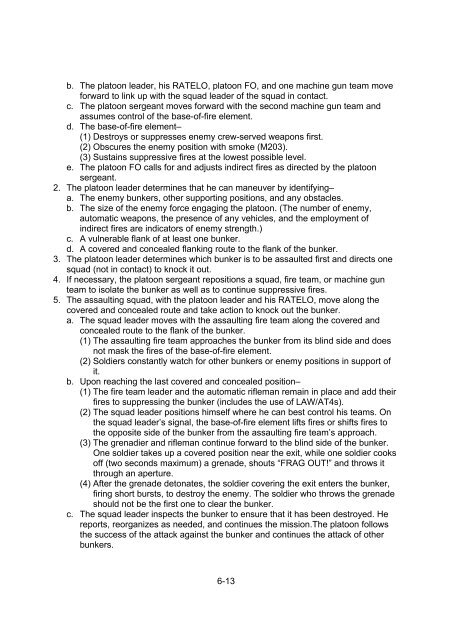Create successful ePaper yourself
Turn your PDF publications into a flip-book with our unique Google optimized e-Paper software.
. The platoon leader, his RATELO, platoon FO, and one machine gun team move<br />
forward to link up with the squad leader of the squad in contact.<br />
c. The platoon sergeant moves forward with the second machine gun team and<br />
assumes control of the base-of-fire element.<br />
d. The base-of-fire element–<br />
(1) Destroys or suppresses enemy crew-served weapons first.<br />
(2) Obscures the enemy position with smoke (M203).<br />
(3) Sustains suppressive fires at the lowest possible level.<br />
e. The platoon FO calls for and adjusts indirect fires as directed by the platoon<br />
sergeant.<br />
2. The platoon leader determines that he can maneuver by identifying–<br />
a. The enemy bunkers, other supporting positions, and any obstacles.<br />
b. The size of the enemy force engaging the platoon. (The number of enemy,<br />
automatic weapons, the presence of any vehicles, and the employment of<br />
indirect fires are indicators of enemy strength.)<br />
c. A vulnerable flank of at least one bunker.<br />
d. A covered and concealed flanking route to the flank of the bunker.<br />
3. The platoon leader determines which bunker is to be assaulted first and directs one<br />
squad (not in contact) to knock it out.<br />
4. If necessary, the platoon sergeant repositions a squad, fire team, or machine gun<br />
team to isolate the bunker as well as to continue suppressive fires.<br />
5. The assaulting squad, with the platoon leader and his RATELO, move along the<br />
covered and concealed route and take action to knock out the bunker.<br />
a. The squad leader moves with the assaulting fire team along the covered and<br />
concealed route to the flank of the bunker.<br />
(1) The assaulting fire team approaches the bunker from its blind side and does<br />
not mask the fires of the base-of-fire element.<br />
(2) Soldiers constantly watch for other bunkers or enemy positions in support of<br />
it.<br />
b. Upon reaching the last covered and concealed position–<br />
(1) The fire team leader and the automatic rifleman remain in place and add their<br />
fires to suppressing the bunker (includes the use of LAW/AT4s).<br />
(2) The squad leader positions himself where he can best control his teams. On<br />
the squad leader’s signal, the base-of-fire element lifts fires or shifts fires to<br />
the opposite side of the bunker from the assaulting fire team’s approach.<br />
(3) The grenadier and rifleman continue forward to the blind side of the bunker.<br />
One soldier takes up a covered position near the exit, while one soldier cooks<br />
off (two seconds maximum) a grenade, shouts “FRAG OUT!” and throws it<br />
through an aperture.<br />
(4) After the grenade detonates, the soldier covering the exit enters the bunker,<br />
firing short bursts, to destroy the enemy. The soldier who throws the grenade<br />
should not be the first one to clear the bunker.<br />
c. The squad leader inspects the bunker to ensure that it has been destroyed. He<br />
reports, reorganizes as needed, and continues the mission.The platoon follows<br />
the success of the attack against the bunker and continues the attack of other<br />
bunkers.<br />
6-13


